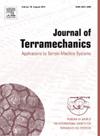Tractive performance of rigid wheel in granular media using coarse-scale DEM models
IF 3.7
3区 工程技术
Q3 ENGINEERING, ENVIRONMENTAL
引用次数: 0
Abstract
Understanding interactions between wheel and granular media in variable loading conditions is critical for prediction of mobility of wheeled vehicles in off-road environments. The discrete element method (DEM) is routinely used for modeling vehicle off-road performance, but the method’s accuracy is often not fully established.
In this work, the DEM modeling accuracy is assessed by the comparison of ten DEM soil models with laboratory soil-bin measurements of net traction, gross traction, and sinkage of a wheel operating in sand. Laboratory soil-bin measurements, serving as reference for DEM simulations, were taken from physical experiments by Shinone et al. (2010), examining a 165/60R13 wheel with circumferential velocity of 97.6 mm/s and vertical contact load of 980 N in varying slip conditions.
The set of ten DEM models was selected from the Generic EDEM Material Model database from Altair®’s EDEM™ software package, choosing the materials matching the bulk density and angle of repose for dry sand.
Given the large particle size and no additional calibration of the DEM models, finding overall reasonable match with the gross traction from lab measurements and identifying a material predicting the net traction with a satisfiable accuracy encourages further use, refinement, and calibration of the DEM-based soil models.
利用粗尺度 DEM 模型实现刚性车轮在颗粒介质中的牵引性能
了解车轮和颗粒介质在不同载荷条件下的相互作用对于预测轮式车辆在越野环境中的机动性至关重要。离散元法(DEM)通常用于车辆越野性能建模,但该方法的准确性往往尚未完全确定。在这项工作中,通过比较十个 DEM 土壤模型和沙地车轮净牵引力、总牵引力和下沉量的实验室土壤箱测量结果,评估了 DEM 建模的准确性。作为 DEM 模拟参考的实验室土仓测量数据来自 Shinone 等人(2010 年)的物理实验,在不同滑移条件下对圆周速度为 97.6 mm/s、垂直接触载荷为 980 N 的 165/60R13 车轮进行了测试。由于 DEM 模型的粒度较大,且无需额外校准,因此从实验室测量结果中找到了与总牵引力总体上合理匹配的材料,并确定了一种可预测净牵引力且精度令人满意的材料,从而鼓励了对基于 DEM 的土壤模型的进一步使用、改进和校准。
本文章由计算机程序翻译,如有差异,请以英文原文为准。
求助全文
约1分钟内获得全文
求助全文
来源期刊

Journal of Terramechanics
工程技术-工程:环境
CiteScore
5.90
自引率
8.30%
发文量
33
审稿时长
15.3 weeks
期刊介绍:
The Journal of Terramechanics is primarily devoted to scientific articles concerned with research, design, and equipment utilization in the field of terramechanics.
The Journal of Terramechanics is the leading international journal serving the multidisciplinary global off-road vehicle and soil working machinery industries, and related user community, governmental agencies and universities.
The Journal of Terramechanics provides a forum for those involved in research, development, design, innovation, testing, application and utilization of off-road vehicles and soil working machinery, and their sub-systems and components. The Journal presents a cross-section of technical papers, reviews, comments and discussions, and serves as a medium for recording recent progress in the field.
 求助内容:
求助内容: 应助结果提醒方式:
应助结果提醒方式:


